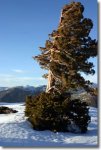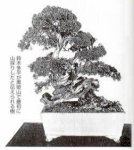My point is that the so-called green helmet (which you brought up by the way) is the lazy man's way of copying nature. That most wild windswept junipers in the sierras do not have a neat green helmet. Certainly no wild shimpaku did either. That most juniper bonsai (most conifers in fact) are made with the green helmet because it's easy. That, as Vance mentioned, many beautifully wild yamadori junipers are ruined by being domesticated by topping them with a green helmet. So much so that all you can see is a trunk with some deadwood and a green helmet and that is pretty crappy done like that (IMO). That the models for this modern styling come from other bonsai and not real trees and because of that the original appreciation has been refined out of existence. Another example; The Japanese practice of polishing juniper trunks has put much pressure on every other juniper grower to do the same because it attracts attention but unfortunately detracts from the (once seen as) valuable wabi.
And yes before you say it, everyone can do and say what ever the hell they like....which is what I'm doing.







